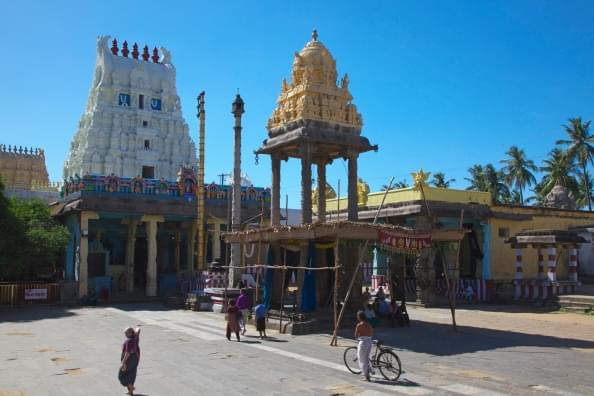Books
Not Just Smart Cities; India Needs Smart Temple Entrepreneurship Too
R Jagannathan
Apr 13, 2016, 03:53 PM | Updated 03:53 PM IST
Save & read from anywhere!
Bookmark stories for easy access on any device or the Swarajya app.


- Temples are not just places of worship; they are places of energy, forums for social bonding and magnets for investment.
-
India’s old temples are overcrowded and simply don’t attract younger new followers due to dingy interiors and excessive pandering to the orthodox.
- New temples must be built to meet different faith needs, free from government control and allowing new traditions broadly rooted in Hinduism.
The ongoing case in the Supreme Court for allowing women in the 10-50 age group to enter Sabarimala temple, abode of the celibate Lord Ayyappa, and the Puttingal temple fire-cracker tragedy in Kerala that killed 110 devotees, should spark a new burst of temple entrepreneurship in India. India cannot grow purely on the basis of agriculture, industry and services. Faith is an important driver of growth, catering as it does to both temporal and spiritual needs.
The Left and the Marxists may believe that “religion is the
opium of the people”, but this is hogwash; religion is a crucial ingredient in culture
and character, and temples are not just places of worship. They are places of energy,
and forums for social bonding. They are not just about faith; they are economic
powerhouses, and a magnet for investment. Every temple draws not only the usual
flower sellers, puja material vendors, eateries and related paraphernalia, but attracts investment in transport, tourism and hotels, apart from catalysing many other economic
activities.
Smart cities and smart development need smart temple entrepreneurship. After Stand Up India, it is time for Bow Down India too.
The problem is that India’s old temples are overcrowded – as the
Puttingal tragedy showed – and demographically far removed from the emerging
market for spirituality. Old temples, with their dingy interiors and excessive pandering
to the orthodox and the conservative, simply do not attract new followers.
Especially the young. And India is nothing if not young and restless.
Consider the demography: about 28 percent of India’s population
is under 14 years of age, and these people will be interested in religion and
faith over the coming years. Another 18 percent is 15-24 years of age, and is
already a clear market for faith. Taking the under-14 and 15-24 age groups makes a phenomenal current and future market of 460 million souls (assuming 80
percent of Indians in this age group are Hindus).
Some 41 percent of the population is in the productive 25-54
years category, which means careers may matter more than faith for many of
them. But they will be big spenders on behalf of the other age groups. This is
where the money for temple building may come from. Not that this group will be
disinterested in temples, but they have other concerns. They will pay to give
themselves a faith insurance. The 13 percent in the above-55 category (people
who can sight retirement or are already senior citizens) are sure markets for
religion, but this market is probably already served by existing temples.
The problems with the older, established temples are the
following:
One, they are run by the state, more to maximise revenues than to
build faith. They run a quick-moving assembly line, where the devotee, often
after hours of waiting in a queue, gets less than 10 seconds of darshan. Getting
into the Tirupati temple is no different from getting into a crowded suburban
train in Mumbai or Kolkata. One is surprised how faith even survives this
push-and-pull.
Two, these are one-size-fits-all temples. There is no attempt to
deal with different faith segments (young, old, middle-aged, women) differently.
Basic consumer principles suggest that faith is no different a market than that
of any consumer product. A segmented approach to serving faith needs differentiated
temples, with different attractions and revenue models. Temples for senior citizens
need peace and quiet; those for the young can be bustling and energetic with
lots of activities.
Three, there is little space for growth and expansion – one reason
for Puttingal’s tragedy.
Four, there is very little scope for experimentation, since
tradition dictates everything. Growth is hampered by the past – as is the case
with Sabarimala.
New temples, built to meet different faith needs, can not only be freed from the dead hand of government control (most temples in south India are administered by state governments, and also many in the north), but can also be differently structured. There can be pure charity-based (hundi collections) temples, non-profit Section 25 temples, and for-profit temples that can do many commercial activities to sustain regular visits.
Some temples
can be quasi-malls where people congregate not only for their daily or weekly worship,
but also to spend time with friends doing other things. There could be gyms,
food parks, libraries, reading rooms, entertainment spots (for faith-based
movies), and shopping centres. New temples can also be funded with structured
financial products, including EMI schemes, monthly deductions from salaries,
zero-coupon bonds, et al.
While government control is one problem, control by existing
conservative elements can also be deadening. New temples can allow new
traditions – but broadly rooted in Hinduism – to be established, including
temples served by priests voluntarily taken in from all castes, women-only
temples, multi-gender traditions, etc. If differentiated temples can be set up,
the battle for women’s entry into Sabarimala will sound foolish in retrospect.
In fact, Sabarimala, if faced with the prospect of women wandering off to other
temples, may itself change the rules to avoid losing current or future customers.
Once for-profit (or even non-profit) temples get successful, they can create great hospitals, outstanding educational institutions, and even fund scholarships and welfare schemes for the poor. Old age homes and hospices should be an essential part of future temple towns. Even better, they can formally enter the conversion game like Christian and Muslim religious entrepreneurs do. Conversion needs marketing and resources. This calls for resource generation. The old temples are too hidebound to think innovatively on how to expand their faith markets.
Time to energise temple entrepreneurship.
Jagannathan is former Editorial Director, Swarajya. He tweets at @TheJaggi.





